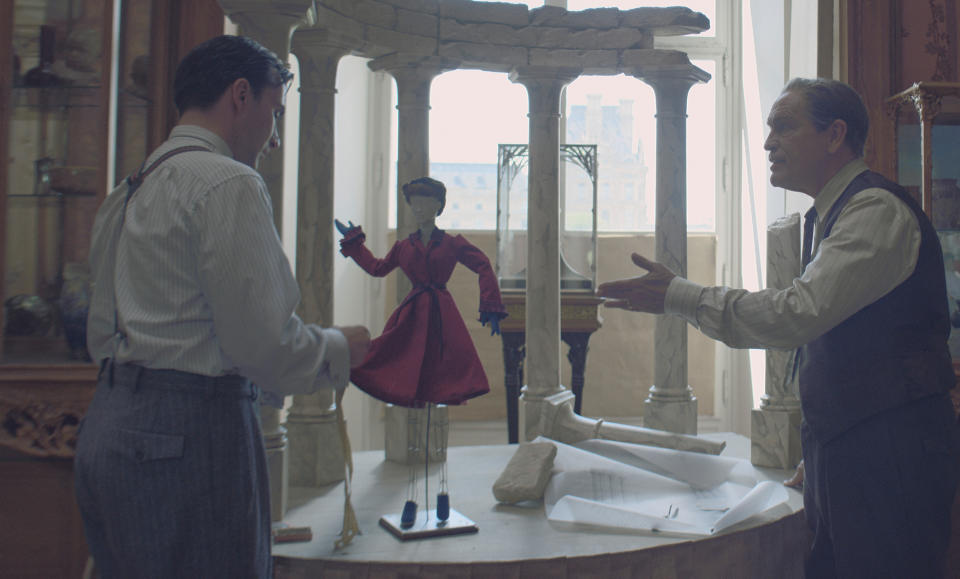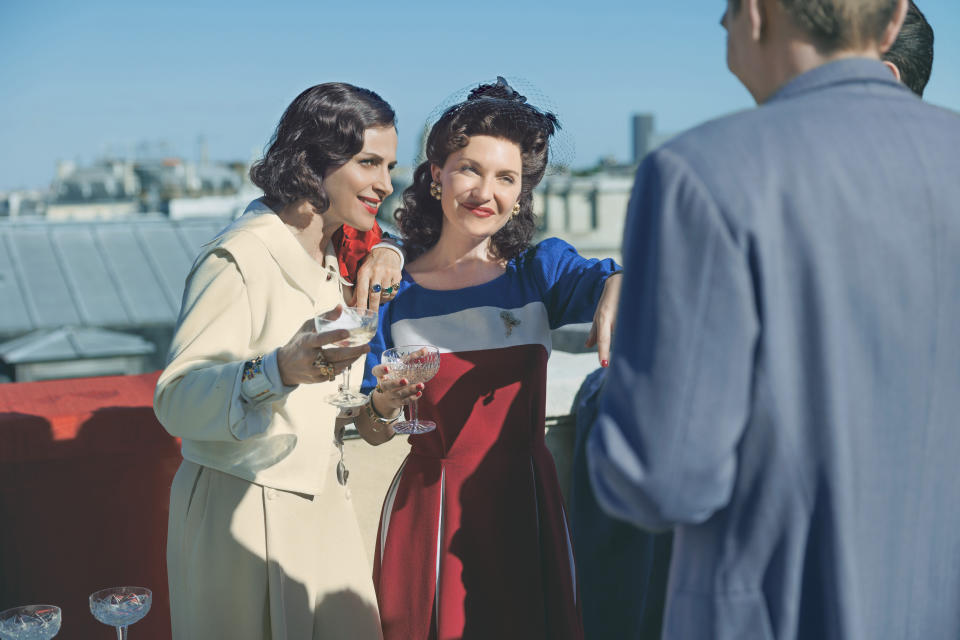‘The New Look’ Creator Todd A. Kessler on Series’ Intentional Objectivity

- Oops!Something went wrong.Please try again later.
For a series named after Christian Dior’s history-making collection, “The New Look” certainly took its time showing the iconic clothes. Actually, the Dior line that made him a household name on both sides of the Atlantic didn’t appear until the final moments of the Apple TV+ drama’s season finale, a choice that might have been more surprising if what came before hadn’t been so riveting.
Created by Todd A. Kessler (“Damages,” “Bloodline”), “The New Look” was more interested in the cost (emotional, moral, and mortal) of survival than in Dior’s extravagant collection. Told mainly via flashbacks, “The New Look” chronicled the parallel rise of Dior (Ben Mendelsohn) and fall of Coco Chanel (Juliette Binoche) from the final days of WWII through the launch of Dior’s first solo collection, what Harper’s Bazaar editor Carmel Snow named “the New Look.” Along the way, Chanel’s Nazi ties and Dior’s tragic family life were explored in a staggering amount of detail; the truth about Chanel’s wartime activities has long been known, but to see it unfolding raises complicated questions about the choices we make.
More from IndieWire
With the full season now streaming on Apple TV+, IndieWire spoke to Kessler about the show, its surprising critical reaction, and what future seasons might have in store.
IndieWire: “The New Look” is an ingenious Trojan horse — people might expect a frothy look at high fashion, but we walk into a show that is about the lengths that people will go to to survive. Was there any pushback about a show called “The New Look” that doesn’t include those iconic clothes until the very end?
Todd A. Kessler: No, there wasn’t really pushback. The show started for me [after] reading an article celebrating Christian Dior’s 50th anniversary in 1997. And I realized that while I knew the name Dior, I didn’t know anything about the person and the context. And so, for me, it started with the person and the context and World War II and this idea of certainly the darkest moment in the 20th century up to that point and maybe one of the darkest moments of all time. And then out of that, this spirit of how to survive and how creativity led the way and brought the desire to live again. All the things that are towards the end of the season. The show is intended to be more than just one season, if enough people watch and it’s a success for Apple. But the first season just gets us to the starting line Dior, of his success. So by design, this first season is going to really set the table, so to speak, of the context and to have an audience understand that it’s not superficial.
We talked about Glenn Close earlier. When I got her the scripts, she said that she realized that in certain ways she always kind of dismissed couture as superficial. And had no knowledge of where it was coming from for designers like . All of these people lived through this war together.
It’s wild that all of these iconic French designers of mid-century fashion — Dior, Balenciaga, Balmain — were all working together at Lelong’s, and all of their work is so drastically different.
And that was one thing in the fourth episode, with the Théâtre de la Mode, where they designed for the dolls. The beauty of that, where there isn’t enough fabric for all of them to have a collection, and they come together and make these extraordinary dresses in miniature to save couture That’s really, to me, very emotional. People that are friends, but also there’s a great level of competition among them, but they’re all coming together to do this.

Watching that sequence and that storyline, the audience was almost dared to dismiss it. And when you see the final shots of the finished products, you realize that art does matter and detail does matter. And creativity is the thing that will get us through. That was a welcome reminder.
One of the things that’s just been interesting in the critical response is that people either want more fashion, or they want me as the creator to come out and tell them who’s a hero and who’s a villain. They’re uncomfortable with [being asked] to just experience the characters as people, and you can make your own decisions and hopefully put yourself in the shoes of those people and say, “Well, what would I have done?” You’re just trying to survive. But that makes some audience members very uncomfortable, some critics, I think, very uncomfortable. That you may feel one way at the end of an episode and a different way at the end of another episode about the choices that people are making.
Have they never seen “Damages”? You’re not tagging anyone hero or villain.
Right. Right. But it was also extraordinary to film in Paris and the costume designer, Karen Serreau, and the production designer, Anne Seibel, and many people had relatives who were sent to camps. The production designer had a photo of her mother when she was a young girl, and it was the day before they were going to flee Paris, and the mother and her sister are happy but you can see on the faces of the parents that they know that they may never come back to Paris. Just this feeling of personal connection to the story. It’s not that long ago. It was really stunning to try to recreate that time in Paris.
And no pressure on you to come in and do that! We were talking about complicated characters, and no one is a true villain, and no one is a true hero. And I’m fascinated by the tightrope that you and Juliette Binoche walk with Chanel. You don’t necessarily sympathize, but you understand. What was it like finding that balance?
I researched the show for seven years and read everything that I could possibly find on Chanel, and Juliette did a lot of her own research, reading a lot of the same things, but then there are some texts that are only in French. And we know more about her childhood than what you see in the first season; we would get that in subsequent seasons, Chanel as a younger person, and understand more of how she became this trailblazer and someone who started her business at a time when it was illegal for women to have bank accounts in France. She was an orphan, her mother died and her father dropped her off at a convent and really just abandoned her there at the age of 10. And the aesthetic in the convent influenced her designs and also trying to liberate women and get them out of the corset and create clothes that were more modern. This is back in the ’20s and ’30s. And then Dior comes along and puts them back in a corset and makes them objects of beauty, and the dresses are so heavy and they can’t even walk.
And Chanel has that iconic line about Dior: He doesn’t dress women, he upholsters them.
So the feeling was: She’s trying to survive and [then] her relationship with men and with power and what it means to be functioning in that world. So, it wasn’t that it was necessarily difficult to empathize with Chanel but to be able to hold two aspects of her. One is, you know, the Nazis are villains. We’re not telling a nuanced story of the Nazis that aren’t oppressors, but her relationship with that power. To understand what does it mean. In the first episode, she’s brought to an apartment by Spatz where Jews lived and he said, “You can take anything that you’d like from this apartment.” And the feeling is, “Is she being tested in that moment? Are you going to come with the power? Are you going to stand up to power?” So you may be rooting for her to not take anything, but she’s rooting for her own survival. And she could easily be sent to a camp. The arbitrariness of who was arrested, sent to camps. So it was trying to get underneath that, to portray Chanel as a living, breathing person. Even though she creates clothes that have labels, to not have us put a label on her.

And I was delighted that French movie star Arletty is a character and got to say her very famous line about her relationship with a German man: “My heart may belong to France, but my ass is international.” And then, by the end of that episode, you see her having her head shaved because of that relationship, and Chanel makes the point — which does not get brought up that often — that it’s the women who are punished for socializing with Nazis. And you suddenly get a new glimpse into what it was like for Chanel at that time.
And there’s a moment where Arletty is telling Chanel that she fell in love. He happened to be a Nazi, or a German, but she fell in love. And it’s also their life, you know? What people don’t really have a sense of, and I didn’t until I got into it, is that the Nazi occupation of Paris lasted for four years. And it’s not as if two years in, the French were like, “Oh, you know, we only have another, what? Two more years left?” So you meet someone, and you fall in love. I mean, this is your life.
And what’s also interesting about the Arletty head shaving is that I did a lot of research, and there’s a lot of research which says that she did get her head shaved, and then there seems to be a little bit of revisionist history where it’s like, no, no, she didn’t get her head shaved. Many French people, when we were making the show, came up to me: “But you know Arletty didn’t get her head shaved.” So they’re still holding on to this other story. I mean, it’s documented. But it’s fascinating what people hold on to in their identity.
Well, I hope I get many more seasons, and I hope one of those seasons includes Katharine Hepburn as Coco Chanel on Broadway.
Well, this is an absolutely good story because [Chanel] offered to do the costumes for the show about herself. And they said, “We don’t want you doing the costumes.” And then she was horrified that Katharine Hepburn was playing her. I mean, that’s just almost like a satire. You really couldn’t make that up. It’s so juicy and entertaining to put that in.
“The New Look” is now streaming on Apple TV+.
Best of IndieWire
The 12 Best Thrillers Streaming on Netflix in April, from 'Fair Play' to 'Emily the Criminal'
Quentin Tarantino's Favorite Movies: 61 Films the Director Wants You to See
Sign up for Indiewire's Newsletter. For the latest news, follow us on Facebook, Twitter, and Instagram.

